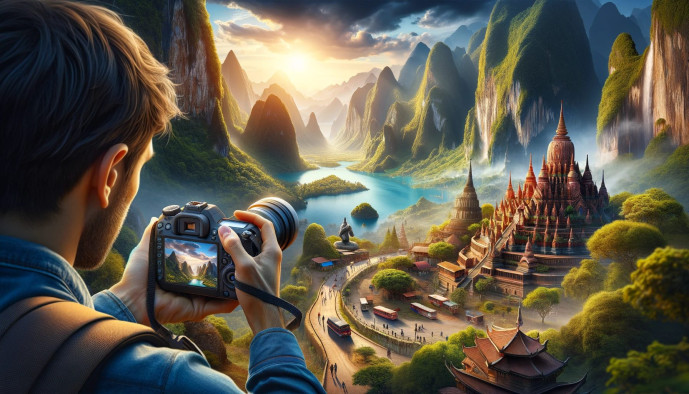Master Travel Photography
Elevate your travel photos with expert composition, lighting, and storytelling tips.

Understanding Travel Photography
Defining Travel Photography
Travel photography is the art of capturing the essence of a place and its people, telling the story of a journey through images. It’s a visual diary that blends landscapes, portraits, street scenes, and the unexpected.
Importance of Storytelling
The heart of travel photography beats in storytelling. A single image can encapsulate a narrative, sharing the spirit of a moment or the ambiance of a locale far beyond words.
Essential Gear for Travel Photography
Choosing the Right Camera
Select a camera that resonates with your travel style – whether it’s a lightweight mirrorless system, a versatile DSLR, or a high-quality compact camera.
Lenses for Different Scenarios
Invest in a wide-angle lens for majestic landscapes, a telephoto lens for distant subjects, and a fast prime lens for intimate street photography.
Accessories to Consider
Don’t forget a sturdy tripod, extra memory cards, and a reliable camera bag. A polarizing filter can be a game-changer for reducing glare and enhancing skies.
Technical Skills Development
Mastering Camera Settings
Knowledge of ISO, aperture, and shutter speed is fundamental. Experiment to understand how these settings influence exposure and motion capture.
Composition Techniques
Employ the rule of thirds, experiment with leading lines, and dare to break traditional rules for a creative twist.
Understanding Light and Time of Day
Chase the golden hour for warm, flattering light, and use the blue hour for moody, cool-toned scenes. Learn to make the most of midday light too—it’s all about adaptability.
Creative Approach
Finding Unique Perspectives
Look high, look low, and look behind you. Sometimes the best shot is the one not taken by the crowd.
Capturing Local Culture and People
Engage with locals and capture candid moments that reflect the community’s heartbeat. Remember, a smile transcends language barriers.
Embracing Spontaneity
Let go of rigid itineraries. Sometimes the most memorable images are born from the unplanned detours.
Post-Processing Techniques
Basic Editing Skills
Master the basics of exposure correction, color balance, and cropping. A well-edited photo should look like it hasn’t been touched at all.
Advanced Editing Tips for Impact
Dabble in layer masks and luminosity adjustments for more control over your edits. Subtlety is key—avoid overcooked results.
Organizing and Storing Photos
Invest in robust storage solutions and develop a naming convention for files. Digital clutter is the enemy of creativity.
Ethical Considerations in Travel Photography
Respecting Local Customs and People
Always seek consent before snapping portraits. Be a storyteller, not a story taker.
Environmental Consciousness
Leave no trace but your footprints and take nothing but photos. Be an ambassador for responsible travel.
Sharing and Showcasing Your Work
Social Media Strategies
Craft a narrative with your Instagram grid or Twitter feed. Engage with your audience—social media should be a two-way street.
Building a Portfolio
Curate your portfolio to showcase your versatility and vision. Your portfolio is your handshake to the world.
Tips for Getting Published
Research publications that align with your aesthetic. Tailor your pitches, and remember, rejection is not the end—it’s a redirection.